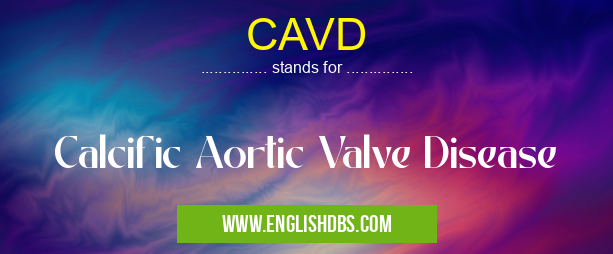What does CAVD mean in DISEASES
CAVD stands for Calcific Aortic Valve Disease. This condition is a medical disorder where the affected person has calcium deposits in their aortic valve. As the name suggests, this causes symptoms like chest pain or difficulty breathing due to an obstruction in blood flow. It can be incredibly serious and requires urgent medical attention if left untreated. CAVD occurs in all age groups, but is most commonly seen in adults over 40 years of age.

CAVD meaning in Diseases in Medical
CAVD mostly used in an acronym Diseases in Category Medical that means Calcific Aortic Valve Disease
Shorthand: CAVD,
Full Form: Calcific Aortic Valve Disease
For more information of "Calcific Aortic Valve Disease", see the section below.
What Causes CAVD?
The exact cause of CAVD is unknown, however there are several factors that may contribute to its development such as aging, genetics, smoking, high blood pressure and diabetes. Many times these conditions are pre-existing and lead to an accumulation of calcium on the aortic valve leading to narrowing and eventually blockage of the valve opening. This reduces the effective blood flow from your heart into your body which results in decreased oxygen supply to all parts of your body resulting in symptoms like chest pain or shortness of breath.
Diagnosis Of CAVD
A diagnosis for CAVD usually involves a series of tests that look into your heart function and rule out other causes before confirming a diagnosis. Doctors often use echocardiography to check the structure of your heart and identify any abnormalities caused by calcium deposition on the aortic valve leaflets or narrowing due to stenosis. They might also use stress tests and cardiac MRI scans along with other methods such as biopsy or angiogram depending on individual cases.
Treatment Of CAVD
Treatment for CAVD depends on how advanced stage it is at detection. Doctors might recommend lifestyle changes such as quitting smoking, exercising regularly and eating healthy foods to reduce further progression. Medications such as anticoagulants might be necessary to help prevent formation of blood clots from plaque buildup inside arterial walls near affected valves causing obstruction in blood flow resulting in stroke risks or even death if not treated early on time! In some cases surgery might be needed to replace damaged valves with artificial ones that work correctly without any disruption in normal functioning of heart pumps!
Essential Questions and Answers on Calcific Aortic Valve Disease in "MEDICAL»DISEASES"
What is CAVD?
Calcific Aortic Valve Disease, or CAVD, is a form of heart valve disease where calcium builds up in the aortic valve and prevents it from properly regulating the flow of blood through the heart.
Who is at risk for developing CAVD?
People with an underlying heart condition, such as high blood pressure or diabetes, are at increased risk for developing CAVD. Other risk factors include age over 65, being male, having a family history of CAVD, smoking, and being overweight or obese.
What are the symptoms of CAVD?
The most common symptoms of CAVD include chest pain or discomfort (angina), shortness of breath (dyspnea), dizziness or fainting (syncope), fatigue, palpitations (heart racing), and swelling in the legs.
How is CAVD diagnosed?
Diagnosis of CAVD is usually made after a physical exam and imaging tests such as echocardiogram (ECG) or cardiac catheterization are performed to measure the severity of the disease. Other diagnostic tests may also be recommended depending on your specific symptoms and history.
How is CAVD treated?
Treatment for CALD usually includes lifestyle modifications such as modifying your diet and increasing physical activity as well as medications to help manage symptoms. In more advanced cases, surgery may be necessary to replace or repair the damaged valve. Your healthcare provider will discuss all treatment options with you before any decisions are made.
Is there anything I can do to prevent developing Calcific Aortic Valve Disease?
There are certain steps you can take to reduce your risk for developing CALD including maintaining a healthy weight, quitting smoking if you currently smoke, eating a healthy diet low in sodium and saturated fats, getting regular exercise and following any advice from your healthcare provider about managing other health conditions that put you at greater risk for developing this condition.
What complications can arise from Calcific Aortic Valve Disease?
Complications associated with mild-moderate cases may include angina (chest pain/discomfort) due to reduced oxygen supply to tissues around your heart caused by restricted blood flow from clogged valves; progressive difficulty breathing due to decreased efficiency when pumping blood throughout your body; arrhythmia's (abnormal heart rhythm); congestive heart failure; infective endocarditis; stroke; hypertension; aneurysms and peripheral arterial disease which could lead to amputation due to lack of circulation.
Can calcific aortic valve disease be reversed?
Unfortunately once calcium has accumulated on the aortic valve it cannot be reversed without surgical intervention such as valve replacement or repair. That being said there are treatments that can help slow down its progression and improve quality of life such as medication adjustments or lifestyle changes like dietary modification.
CAVD also stands for: |
|
| All stands for CAVD |
